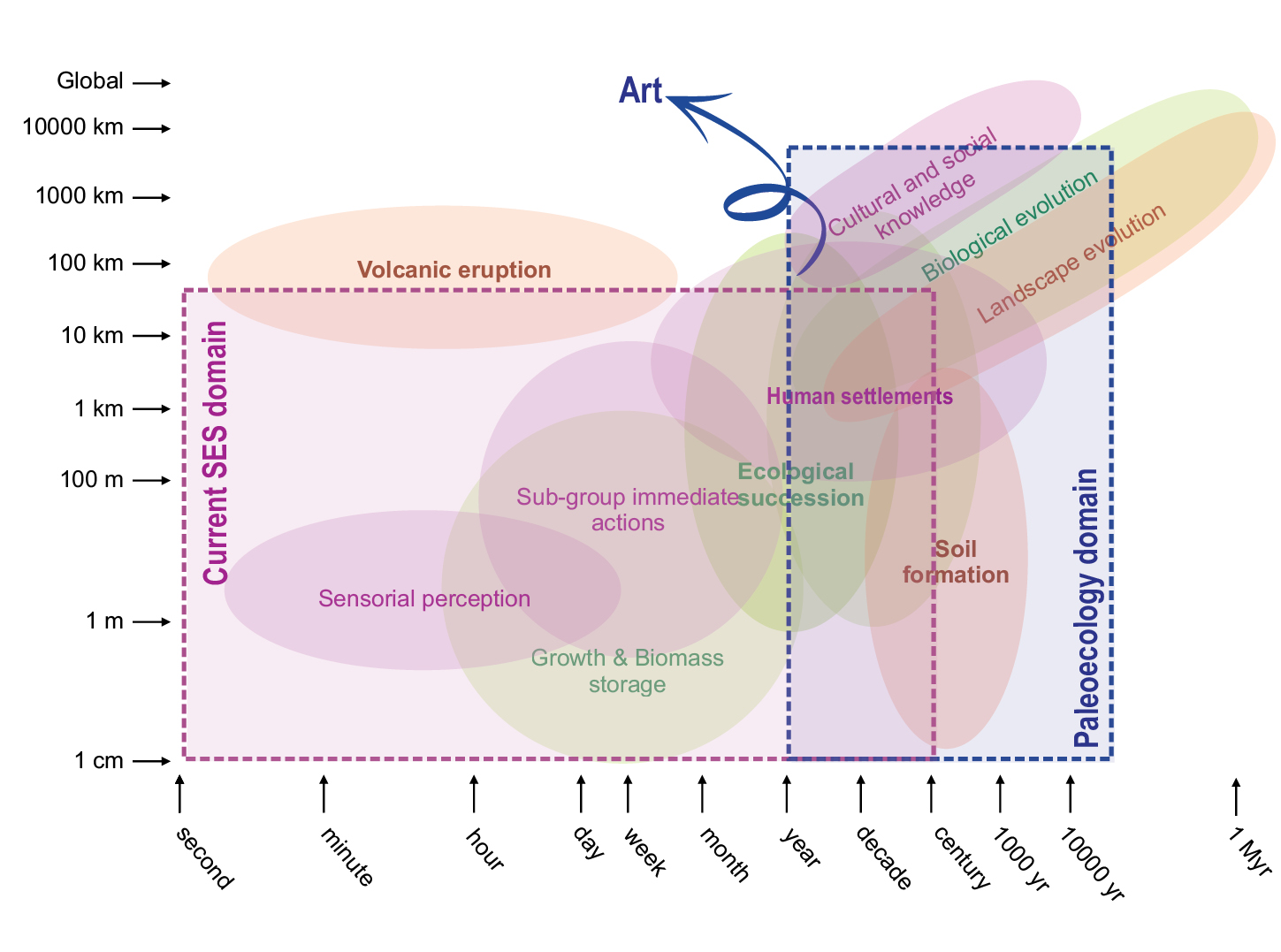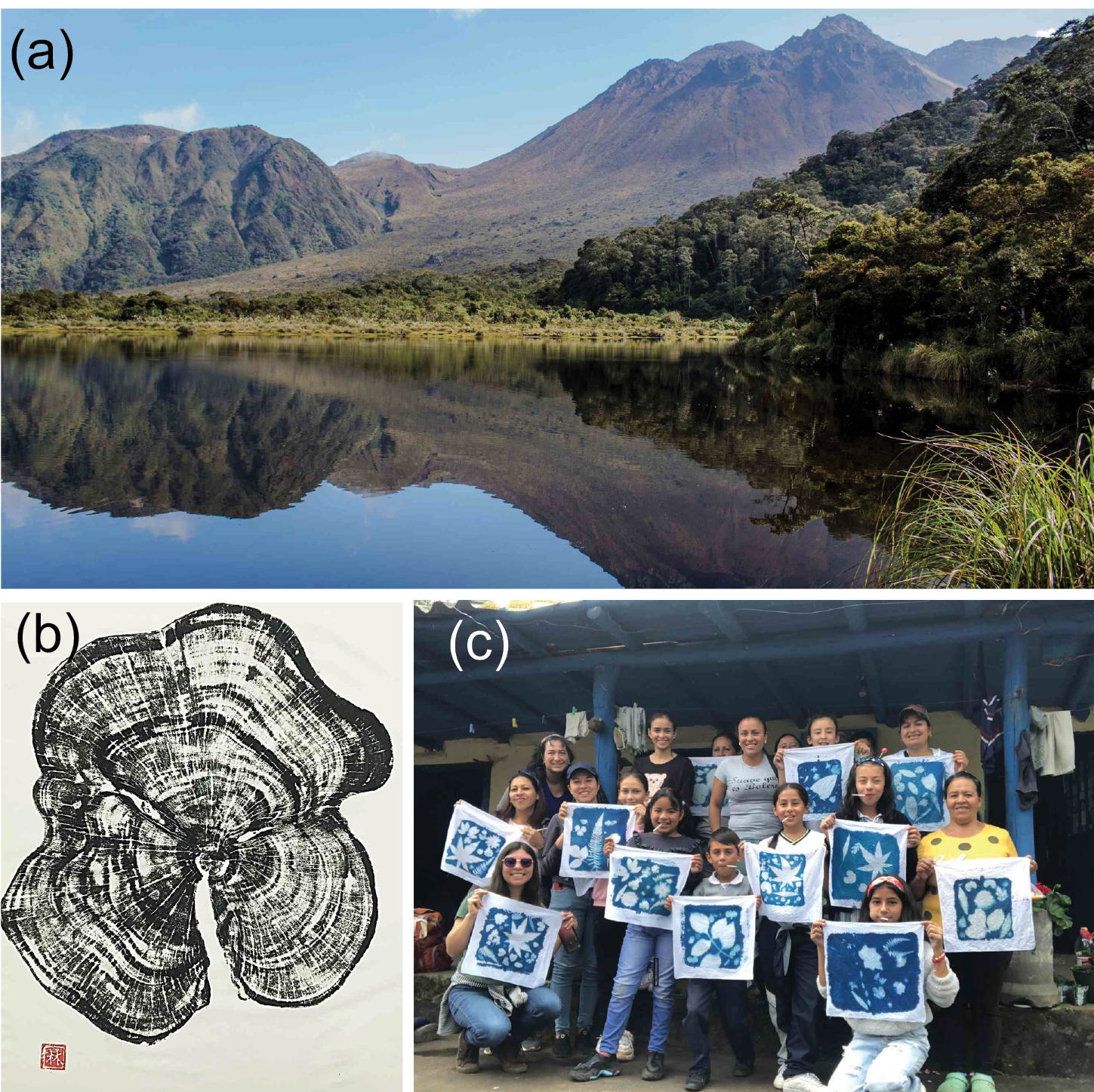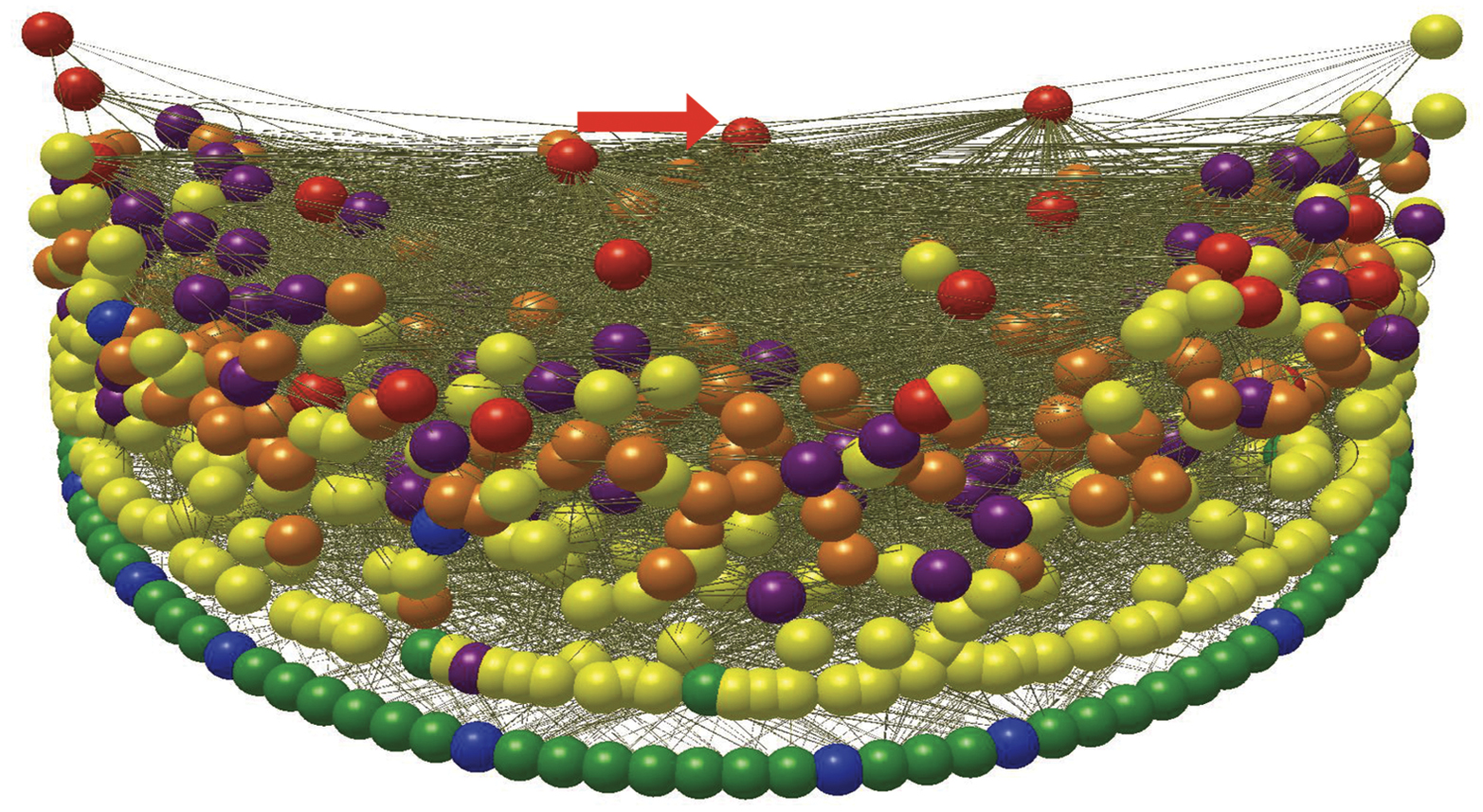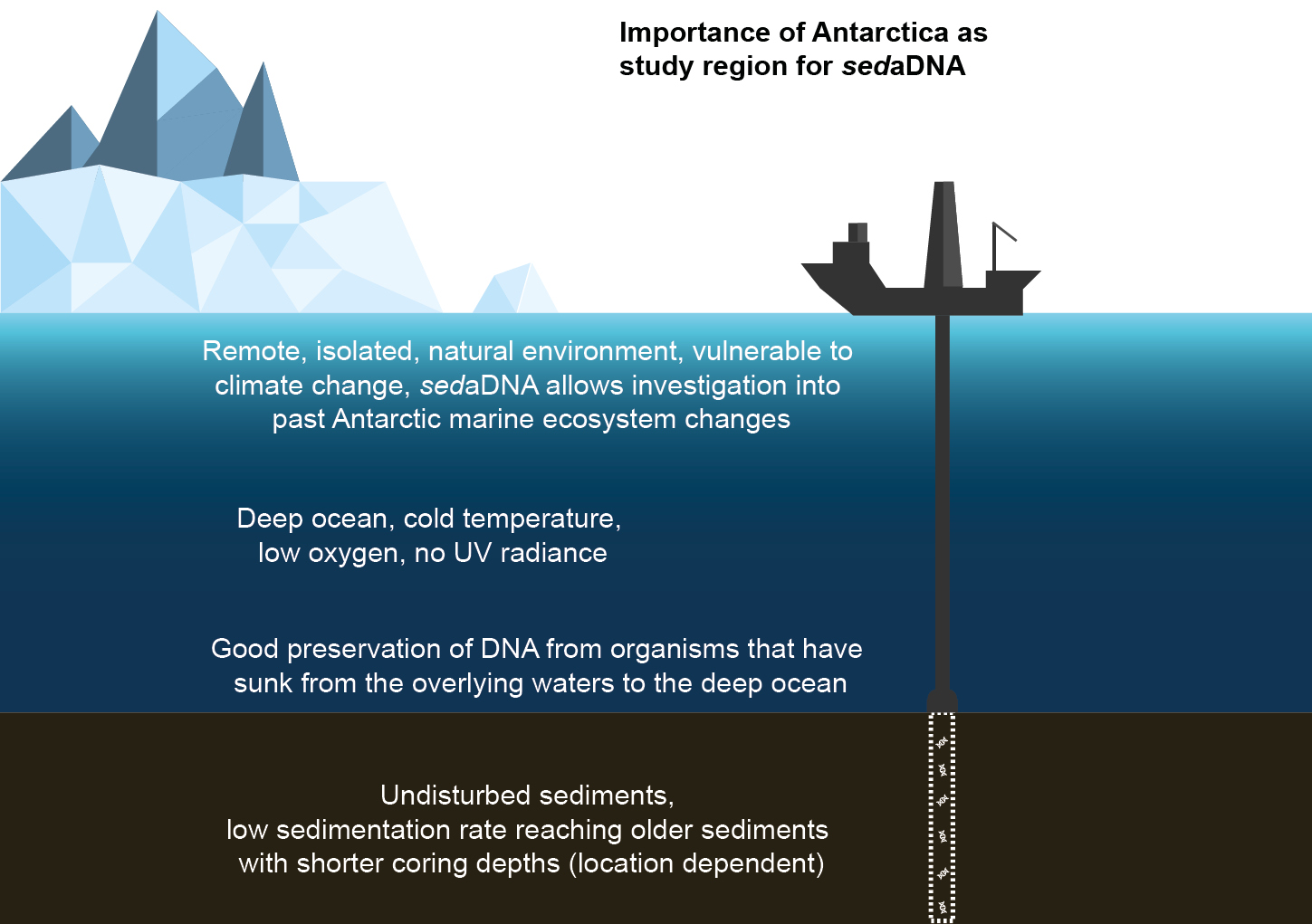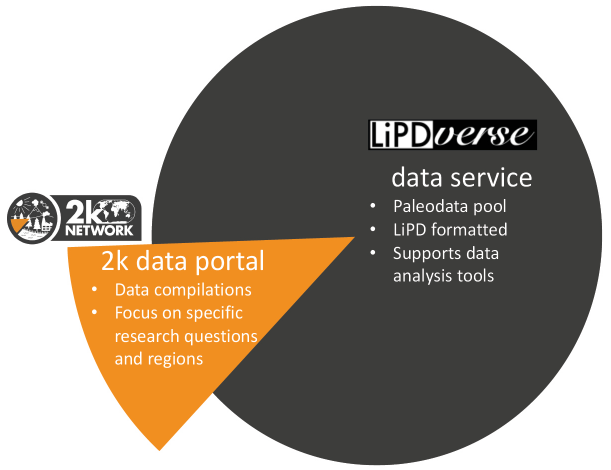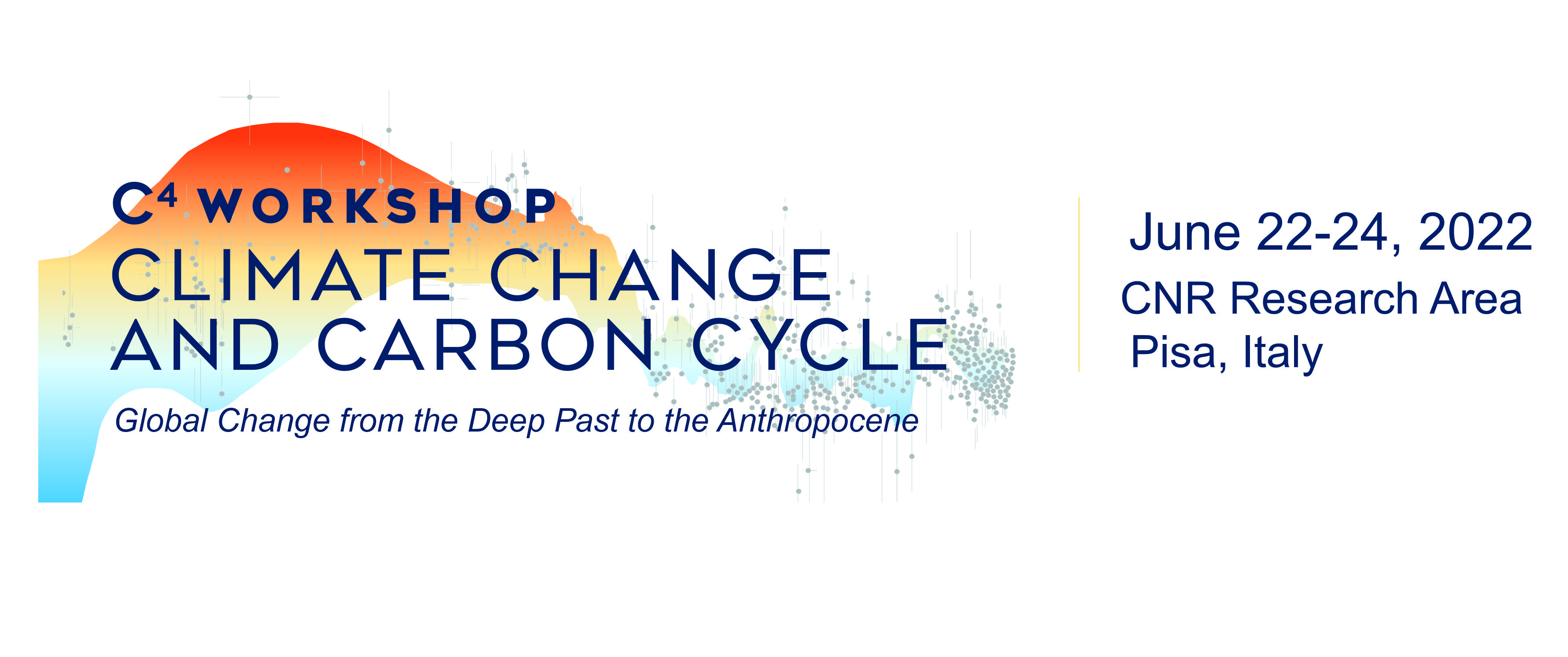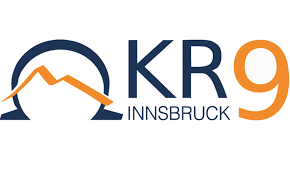PAGES Magazine articles
Artistic approaches exploring concepts such as disturbance, resilience, and memory might help to connect paleoecology and traditional knowledge in active volcanic socio–ecological systems.
Inhabited volcanic territories are socio–ecological systems (SES) comprising not only the physical environment (i.e. geological, biological, climatic), but also social agents (e.g. ideologies, governance systems, beliefs). Thus, volcanic SES emerge from the interdependences between nature and culture, and constitute the perfect setting for addressing questions related to resilience and adaptation to natural hazards (Pardo et al. 2021).
Socio–ecological systems across timescales
Geologic, ecologic, and human processes occur at different temporal and spatial scales. Therefore, understanding their interactions is crucial for providing a firm underpinning for the interpretation of volcanic SES. For example, volcanoes can exist for millions of years, but eruptions can occur in the order of hours–years. Similarly, ecosystems at volcanic settings might be simultaneously modulated by forces that operate at very different timescales (e.g. orbital forcing or a pyroclastic flow). Human systems are not the exception, and current SES are built by many generations of people who have coexisted with natural phenomena in many different and dynamic ways (Fig. 1).
In this context, the interaction between processes and scales must be considered when reconstructing the long-term history of SES, and connect it with present generations. Therefore, an integration of methodological frameworks, wherein humans are components of processes operating at multiple spatial and temporal scales, is necessary.
Paleoecological multi-proxy techniques are tailored to face such complexity. Reconstructing the history of volcanic ecosystems through time, by simultaneously comparing vegetation (e.g. pollen), geological (e.g. geochemistry), and human-related proxies (e.g. charcoal from human-ignited fires, archaeological remains), offers the unparalleled possibility to reconstruct multiple lines of evidence throughout millennia. Such reconstructions serve as scenarios for testing hypotheses on causality, interconnectedness, and coexistence between natural and anthropogenic factors.
However, connecting the results from paleoecological reconstructions to modern societies is challenging, and they are rarely informative and meaningful enough to intervene in present configurations of SES. Here is where art becomes a powerful tool to fill the gap between past and present settings.
In volcanic settings such as the Doña Juana volcano in southwestern Colombia, the last volcanic eruption occurred almost a century ago (Pardo et al. 2023). However, people inhabiting such territories today struggle with the idea that their home is still an active volcano. The consequences of past eruptions on ecosystems and human societies have been buried and eroded by time. This poses the challenge of learning how past societies coexisted with this type of natural hazard.
Art has the power to evoke meaningful and emotional reactions in people, connecting personal memories to pasts generation. It may also connect with non-material aspects of such relationships (e.g. religious beliefs), which are completely out of the scope of paleoecology. Art, thus, acts as a bridge between our scientific-based findings and modern societies in many ways. Art helps to recall and reconstruct hidden and lost memories, which in this case involve plants, climate, and the volcano as evolving entities. Art might be used as an ethnographic tool to collect and share information about current and past human practices and knowledge, which might become crucial when interpreting paleoecological diagrams.
Here, two specific examples where art compliments paleoecology are presented. They not only help to communicate scientific concepts, but also provide new avenues to co-construct knowledge between local tradition and science. These experiences derive from the ongoing study of inhabited active tropical volcanoes (Pardo et al. 2021; Fig. 2).
The first example is inspired by the effect of fire in volcanic settings, which is preserved and gets manifested as individual burned trees. By using fire in the lab/studio, we can mimic the charring process that occurs naturally during eruptions and learn about wood preservation and the specific environment around the tree. The second example is the use of cyanotypes as an artistic technique that we have used with local communities to explore intergenerational memories about plants inhabiting the ecosystem near the volcano.
Recalling the memory of single trees through fire
Reconstructing past fires has become one of the main areas of interest when tackling past human–nature interactions. Fire in paleoecology is traceable by performing charcoal analysis in sediments, and more recently, with the help of more sophisticated techniques, paleoecologists have been able to distinguish between different fire regimes, combustion types, and fuel sources (e.g. Vachula et al. 2021). Ancient human practices related to, for example, cooking, hunting, or certain agricultural systems, can thus be traced back and differentiated from one another. But natural wildfires are also particularly common in volcanic settings, and are responsible for triggering deep and instantaneous changes in SES. In volcanic settings local fires are often caused by lightning, which is common during eruptions, but most of all, due to the high temperatures of pyroclastic and lava flows burning vast extensions of land and human infrastructures in their paths. In some cases, charred remains can be instantly buried by ash or lahars, favoring their exceptional preservation, and turning them into time capsules for next generations.
In volcanic landscapes, particularly where explosive eruptions occurred, it is common to find partially or fully burned timber embedded within large deposits of tephra (e.g. Hudspith et al. 2010). Such botanical remains are exceptionally well preserved and suitable as paleoenvironmental archives due to the water-repellent properties of charcoal, and the rapid burial by ash (Scott and Jones 1991).
Shou Sugi Ban, a Japanese art technique from the 18th century, uses this same principle to weatherproof and preserve wood for decades. In this sense, fire not only works as an agent of destruction, but it is also a medium to preserve legacies. By exploring this dual nature of fire, it is possible to use the remains of charred wood for artistic purposes to communicate ecological and geological concepts related to the history of ancient trees (e.g. age and identity of the tree, discrete vs. continuous processes), which can be difficult to explain to local communities living in volcanic SES. One example of this application is shown in Figure 2b, in which stamp inks are made from charred trunks to communicate about past ecosystems in volcanic SES. These prints are made in such a manner that the same fossil wood serves scientific purposes and artistic exploration.
Recalling collective memories through cyanotypes
When trained paleoecologists observe fossil pollen grains under a microscope, it is inevitable for them to make assumptions about past ecological settings in order to come up with an informed reconstruction of specific ecosystems in the past.
But what do those reconstructions mean to the communities which have lived on these sites for generations? Are those paleoenvironmental reconstructions meaningful in a broader context? How can we connect local knowledge to the scientific findings of past ecosystems to better interpret our paleoecological diagrams? Art, once again, might become a powerful tool to connect traditional knowledge of living communities in volcanic SES with scientific paleoecological understanding.
The last eruptive phase of the Doña Juana volcano occurred between 1897–1936 CE, four to six human generations ago. This means that a great deal of the collective memories of the event, and the overall knowledge of the society–volcano interactions, have been partially lost. Despite oral tradition, music, and other cultural expressions about the eruption, the youngest generations are particularly disengaged from the concept of the Doña Juana being a potential natural hazard.
To try to close this intergenerational gap, an art workshop was held in Las Mesas, a small town near the Doña Juana volcano, for children and adult women. They discussed the names, uses, and shapes of plants growing in their territory. We produced cyanotypes using local plants as stencils on fabric, which were then embellished with embroidery. Cyanotype is an ancient photographic technique that uses light and a photosensitive solution to print the shape of objects (e.g. plants), and was extensively used as a technique to document botanical collections in the 19th century.
The workshop allowed all the participants to recall the diverse relationships that people have with plants in their region. Using ancient scientific techniques with an artistic perspective enriched the experience. It facilitated an authentic integration of the participants, closed gaps between scientific and non-scientific knowledge and emotional and rational thinking, and created the encounter between past and present.
Acknowledgements
The author thanks Kawsay Cultural Center, all the inhabitants of Las Mesas, Nariño, Colombia, and the EHMS Research Group supported by Universidad de los Andes.
affiliation
Departamento de Ciencias Biológicas, Universidad de los Andes, Bogotá D.C., Colombiacontact
C. González-Arango: show mail address
references
Hudspith VA et al. (2010) Palaeogeogr Palaeoclimatol Palaeoecol 291: 40-51
Pardo N et al. (2021) Nat Hazards 107: 1845-1880
Pardo N et al. (2023) Geol Soc Am Bull: b36557
Archaeoecology is a newly emerging field that uses tools from ecology combined with data from the archaeological record. This new field provides a bridge between paleoecology, which generally focuses on periods before major human impacts, and modern ecology.
How can archaeology deepen our understanding of past ecosystems?
What if archaeology could partner with ecology and paleoecology to give us a better depth of understanding of anthropogenic change? The reconstruction of past ecology allows us to understand changes in the biosphere, to look at long-term ecological fluctuations, paleoclimates, extinctions, speciations, and habitat changes, which are all germane to challenges facing planet Earth today. This is embraced in paleoecological studies which study the ecology of Earth long before Homo sapiens spread across the planet (Rull 2010); yet, there is a wealth of data on how societies interacted with ecosystems in the past, encompassing the extinction of Pleistocene megafauna and continuing throughout the Holocene. Archaeology has long examined the ways that humans impact environments, and how environments impact societies in the past, with these studies falling under the umbrella of environmental archaeology. But, these studies have often neglected to incorporate ecological modeling on archaeological timescales, and have primarily focused on the abiotic environment. With improvements in computational technology, advancements in ecological modeling, and the digitization of archaeological records, it is now possible to gain a more comprehensive understanding of entire ecosystems from the archaeological past.
Recently, we proposed the formal definition of the field of archaeoecology (Crabtree and Dunne 2022). Archaeoecology explicitly integrates questions, data, and approaches from archaeology and ecology, highlighting how archaeological data can be a partner for paleoecological and modern ecological studies. This type of research is not new (Revelles 2021). There are instances in the literature going back decades that address aspects of how humans interact with other species and ecosystems in deep time, and there are increasing calls for integration and synthesis that support interdisciplinary research on these types of questions (e.g. Haldon et al. 2018).
What is archaeoecology?
What is new in this approach is the coalescence of approaches, topics, and prior and future studies under the name archaeoecology, much as paleoecology emerged at the intersection of paleontology and ecology in the first half of the 20th century. By blending contemporary ecological modeling methodologies with archaeological data, we can enhance our knowledge of the trajectory of human-ecosystem interactions across the past 60 kyr. Archaeoecology, then, can be partnered with modern studies of anthropogenic change. By understanding the ways that people in the past manipulated and changed ecosystems, by examining the full connection of these ecosystems, and by modeling these changes, we can better understand the human place in ecosystems worldwide. Archaeoecology, we believe, will enhance the transfer of knowledge and methods across adjacent disciplines and support novel lines of research. Moreover, archaeoecology will provide new ways to investigate old questions, and can provide pathways for education, development, and collaboration at the intersection of ecology, paleoecology, and archaeology. Most importantly, by defining a field of archaeoecology, we recognize how the study of Homo sapiens in ecosystems in the past can aid us in understanding the human place in ecosystems today, and into the future.
Archaeologists have been studying ecosystems for as long as the field has been formally defined, though often only as one external aspect of past society. For example, Clark defined the field of "ecological archaeology" in the 1930s with the Fenland research project, aiming to understand the surrounding environment of the sites where he worked (Smith 1997). In the 1970s, environmental archaeology was formally defined as an archaeological subfield leading to more work within the area of studying past environments (O’Connor 2019). Environmental archaeology typically includes studies of the abiotic environmental context reconstructed via geoarchaeological methods, and cataloguing extant plants and animals via zooarchaeology and archaeobotany. The addition of methods reconstructing things such as past temperature (d'Alpoim Guedes and Bocinsky 2018) or rainfall (Bocinsky and Kohler 2014) via computational modeling, have widened the scope of environmental archaeology. A similar widening of the scope of work via ecological modeling approaches has recently emerged by moving beyond presence/absence accounts of zooarchaeological and archaeobotanical remains, to interactions among taxa in the past (Crabtree et al. 2017). These studies do not typically encompass an understanding of full ecosystems of the past, presenting an opportunity.
Archaeoecology, thus, provides the opportunity to move beyond environmental reconstructions of the abiotic context, building past ecosystems via computational models from the data that archaeologists have been curating for decades (Fig. 1).
An example of archaeoecology in practice
One example of a published archaeoecological study is the work led by Dunne et al. (2016) examining the Sanak Island food web. For this study, researchers created full food webs for the intertidal and marine systems of the Sanak Islands, linking these food webs with data from archaeological excavations studying the Aleut fisher/hunter/foragers, as can be seen in Figure 2.
This study showed the human place in the ecosystem – how humans were highly generalist feeders – and used simulations to show how humans were poised to create cascading impacts on the food web, but did not. This work is one way of showing how the blending of archaeological data with ecological models can lead to greater insights in coupled human-natural systems.
Archaeology as evidence of past ecological interactions
Using new methodological approaches with already collated data provides avenues for many practitioners going forward with this area of study, and enables new ways to work with archival data. As more archaeological sites are analyzed, digitized, and recorded, archaeoecologists can compare similarities and differences across societies, deepening our understanding of the human relationship with ecosystems through space and time (e.g. Freeman et al. 2018). Furthermore, archaeoecology can serve as a valuable connection between paleoecological and ecological studies, using our knowledge of past events at various timescales and critical moments in Earth’s history, to enhance and transform our understanding of existing and future ecosystems.
Archaeological records can serve as evidence of past experiments in sustainability, allowing for a better understanding of modern challenges such as the predicted wave of extinctions and community restructurings likely to be caused by climate change. By examining when and where human actions have positively impacted ecosystems, negatively impacted them, or had no effect, scientists and policy makers can be better equipped to make recommendations for ecosystem resilience in the face of massive change. As a result, archaeoecology can play a crucial role in addressing the challenges of the Anthropocene.
affiliations
1Department of Environment and Society, College of Natural Resources, Utah State University, USA2The Santa Fe Institute, Santa Fe, USA
3Australian Research Council Centre of Excellence for Australian Biodiversity and Heritage, Cairns, Australia
contact
Stefani A. Crabtree: show mail address
references
Bocinsky RK, Kohler TA (2014) Nat Comm 5: 5618
Crabtree SA et al. (2017) J Arch Sci 81: 116-127
Crabtree SA, Dunne JA (2022) Trends Ecol Evol 37: 976-984
d’Alpoim Guedes J, Bocinsky RK (2018) Science Adv 4: eaar4491
Dunne JA et al. (2016) Sci Rep 6: 21179
Freeman J et al. (2018) Proc Natl Acad Sci 115(40): 9962-9967
Haldon J et al. (2018) Proc Natl Acad Sci 115(3): 3210-3218
O’Connor T (2019) Internet Archaeology 53
Revelles J (2021) Appl Sci 11: 8782
We dedicate this special issue of Past Global Changes Magazine to our dear colleague Daniele Colombaroli, who passed away on 11 August 2022. Daniele was a passionate scientist and a compassionate human being with a deep commitment towards innovating paleoscience research through building communities. He was known for his openness, generosity, and ever-readiness in supporting students and colleagues.
Daniele greatly contributed to PAGES’ mission in advancing paleoscience research since his PhD days at the University of Bern. He was instrumental in steering PAGES Global Paleofire Working Group (WG) 2 (pastglobalchanges.org/gpwg2), and establishing the Global Paleofire Database (paleofire.org) as the first open-access archive of fire records across the world. Daniele was an avid advocate of bridging science-policy gaps, thus, creating the PAGES DiverseK WG (pastglobalchanges.org/diversek) which merges paleoecology and local knowledge for better decision-making on environmental and social justice issues.
Daniele utilized paleoecological tools to explore past socio–environmental systems (SES), defined as groups of humans, social elements, and processes that interact with each other and the environment through time (Biggs et al. 2021) and he excelled in his work on the legacy of human impact on present landscapes (Colombaroli et al. 2007, 2014). This need for interdisciplinarity that was key to Daniele’s work on understanding feedbacks and interactions between past natural and human systems is the highlight of this special issue (Fig. 1).
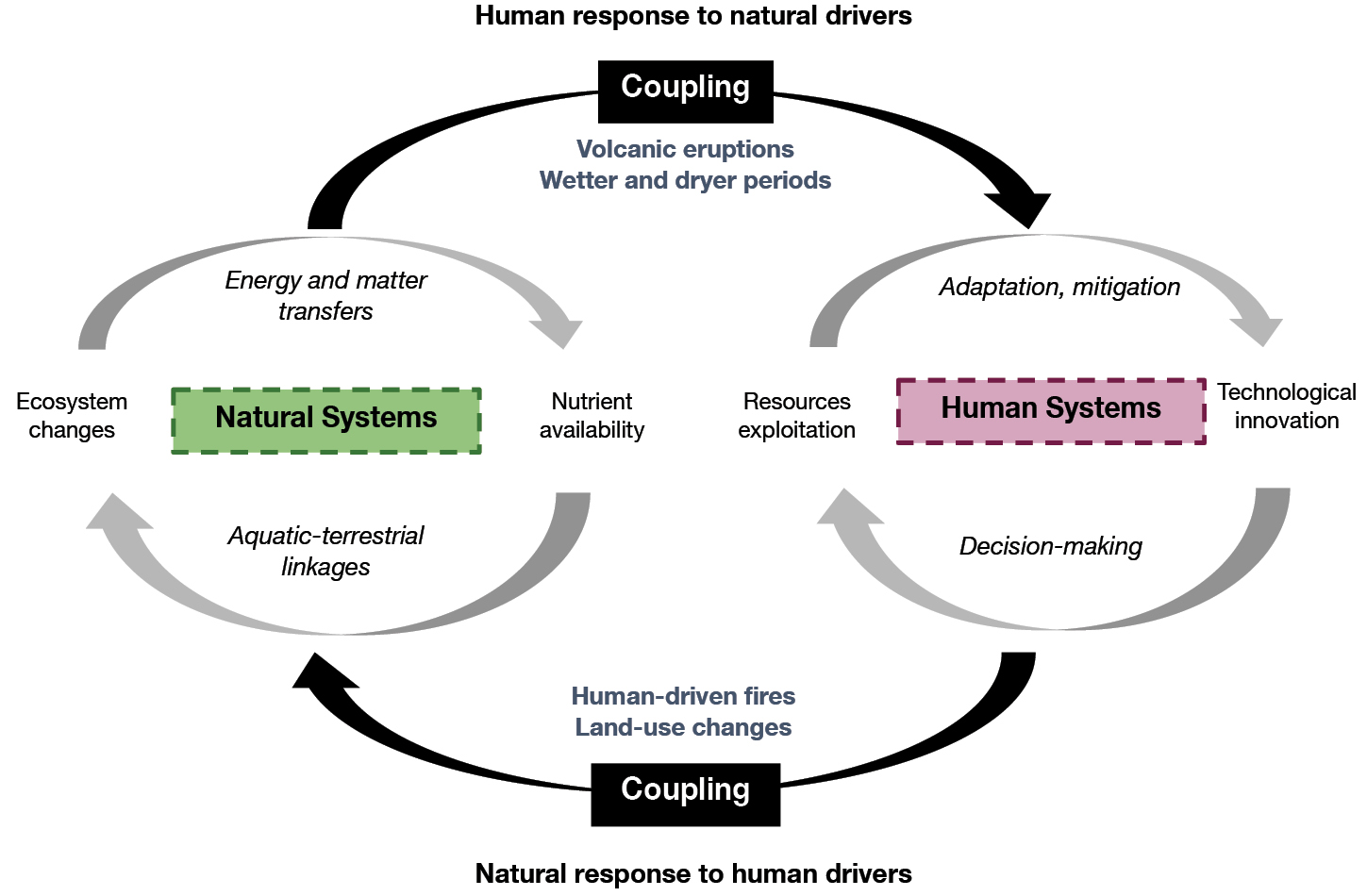 |
|
Figure 1: Diagram showing between and within-systems coupling (natural and human systems), which is the main topic of the current issue. Black arrows represent human (natural) responses to natural (human) drivers. Contributions are placed in the coupled socio–environmental systems framework, adapted from Zimmerer and Vanek as cited in serc.carleton.edu/integrate/teaching_materials/food_supply/student_materials/1059. |
Whereas theoretical and practical implications in studying past SES have been a central topic for PAGES over the last decades (Dearing et al. 2007; Gillson et al. 2017; Latorre et al. 2016), recent perspectives on effective collaboration open new avenues. Crabtree (p. 4) introduces the emerging field of archaeoecology that uses tools and approaches from ecology combined with the archaeological record. Recovering past human perceptions in the face of natural hazards, such as volcanic eruptions, can be achieved by merging paleoecology and art (González p. 6). The application of environmental proxies affected by different spatiotemporal processes (diatoms, ichthyofauna) enables nuanced reconstructions of past human–environmental trajectories in archaeological sites (Zarza et al. p. 8).
The study of past socio–environmental systems also requires developing new methods to disentangle multivariate Quaternary records. Connor (p. 10) reviews recent techniques on landscape reconstruction coupled with the study of ancient DNA in sediments. New approaches in karstic lakes can complement archaeology in understanding the role of the environment in cultural and religious manifestations of the Maya (Rodriguez-Abaunza and Correa-Metrio p. 12). In tropical savannas, determining the role of fire in shaping human–environmental dynamics can be better appraised by analysing pyrogenic compounds from stalagmites (Argiriadis et al. p. 14).
Some studies attest to the importance of regional perspectives for the application of paleoenvironmental and paleoclimatic reconstructions in archaeological sites. Understanding past landscape transformations by Indigenous communities in tropical floodplains is fundamental to present-day management (Lombardo p. 16). Regardless of past precipitation regimes, water availability has shaped cultural innovations to adapt to extreme climatic fluctuations in the central Altiplano (Delaere et al. p. 18), northern Chile (Maldonado et al. p. 20), and western India (Bhattacharya et al. p. 22). Yet, interactions among components of past SES are often asynchronous and nonlinear, with context-dependencies in natural and social processes (Orijemie et al. p. 24). The scaling-up of paleoenvironmental and archaeological records represents an opportunity to hypothesize causes of change across larger spatial and temporal scales, supported by strong locally-rooted inferences, while acknowledging sampling limitations, especially incomplete fossil records. This is particularly the case of environmental drivers in hominin evolution (Kinyanjui et al. p. 26), and cultural responses to global climatic events such as the one at 4.2 ka (Mehrotra and Shah p. 28).
This special issue on past socio–environmental systems speaks to Daniele’s dedication for generating, disseminating, and applying new knowledge. It advocates for mobilization and collaboration as a cornerstone for advancing paleoscience research in underrepresented regions of the globe (Kulkarni et al. p. 30). Therefore, this collection of articles represents Daniele’s view on transcending disciplines, merging diverse evidence, and establishing networks.
affiliations
1Continental and Marine Waters Programme, Institute of Agrifood Technology and Research, IRTA, La Ràpita, Spain2Department of Earth Science, ETH Zürich, Switzerland
³Department of Surface Waters, Research and Management, Eawag, Dübendorf, Switzerland
4Departamento de Ciencias Históricas y Geográficas, Universidad de Tarapacá, Arica, Chile
5Department of Biological Sciences, University of Cape Town, South Africa
contact
Xavier Benito: show mail address
references
Colombaroli D et al. (2007) J Ecol 95: 755-770
Colombaroli D et al. (2014) Glob Chang Biol 20: 2903-2914
Dearing J et al. (2007) PAGES Mag 15(1): 1-32
The study of ancient DNA from sediments (sedaDNA) has great potential for paleoclimate research. Using less than a gram of sediment, this new technique allows ecosystem-wide assessments of Antarctic marine biodiversity over hundreds of thousands of years.
sedaDNA: A new paleo proxy
Marine sedimentary ancient DNA (sedaDNA) is DNA from dead organisms that have sunk from the ocean to the seafloor and been preserved there. Over time, layers of sedaDNA accumulate, forming a record of "who" has inhabited the ocean in the past. sedaDNA analysis is an interesting new paleo proxy because the genetic traces of organisms that do not fossilize can be detected, too (Capo and Monchamp et al. 2022). This means that sedaDNA allows us to study past marine biodiversity quite comprehensively across different levels of the food web, including bacterio- and phytoplankton, zooplankton, and potentially even fish, uncovering wide-scale community shifts as a response to past climatic change. Such knowledge is important, as it helps us to better predict the future of marine ecosystems with ongoing climate change and find management strategies to conserve them.
Antarctica: An important location for sedaDNA research
Polar deep-ocean environments are particularly suitable locations for sedaDNA research because they feature favorable conditions for sedaDNA preservation. These include constantly low temperatures and oxygen concentrations (~0°C, ~5 mL/L, respectively, noting that these values vary regionally; Bensi et al. 2022; Garcia et al. 2018; Meredith et al. 2008), and the absence of UV radiation (Karentz 1989). Antarctica and the Southern Ocean are remote and isolated, making them natural climate laboratories to study long-term global change (Barnes et al. 2006).
Sampling logistics in remote Antarctica are difficult, and for sediment studies in particular, large research vessels or platforms are required to have the capacity to drill into the deep seafloor, sometimes several thousands of meters below the ocean surface (Fig. 1). The most suitable coring system to acquire sediments for sedaDNA analysis is piston coring, which "punches a hole" into the seafloor (rather than using active drilling) and thus recovers undisturbed sediments (Armbrecht et al. 2019). The reliance on piston coring means that sedaDNA analyses are restricted to relatively soft sediments, usually found in the upper sediment layers. However, this is not necessarily a limitation – the recovery of sediments of up to ~490 m below the seafloor has been achieved using piston coring (Tada et al. 2015), which, in many Southern Ocean regions, can reach sediments of ages that are far beyond the timescales that allow for detection of ancient DNA.
Deep Southern Ocean sediments have relatively low sedimentation rates compared to coastal areas. For example, in >3,000 m water depth in the Scotia Sea, sedimentation rates have been determined at ~10–40 cm per 1,000 years (in the upper ~430 m; Weber et al. 2021). Thus, even relatively shallow coring can provide access to sediments of considerable age, allowing sedaDNA investigations into changes in marine food web structures over multiple glacial–interglacial cycles.
Consequently, the limitation on how far back in time ancient DNA analyses can be applied to deep ocean sediments remains not a coring capacity question, but rather one of maximum age of sedaDNA preservation. It is expected that ancient DNA can be preserved for up to ~1 million years under the right conditions (although reports exist of non-replicated/authenticated ancient DNA from bacteria reaching several millions of years; Willerslev and Cooper 2005, and references therein). Until recently, the oldest authenticated sedaDNA had been from terrestrial systems (cave sediments) that were ~400,000 years old (Willerslev et al. 2003). In the Arctic environment, eukaryote sedaDNA has been found in up to 140,000-year-old sediments (Pawłowska et al. 2020). In the Antarctic, marine eukaryote sedaDNA has recently been found in ~1 million-year-old sediments in the Scotia Sea (Armbrecht et al. 2022).
Current applications of sedaDNA research in the Antarctic
Contamination-free sampling techniques are starting to be more commonly used on board research vessels, and sedaDNA research is becoming more frequently incorporated into Antarctic science. For example, in 2019, extensive sedaDNA sampling was undertaken during IODP Exp. 382 "Iceberg Alley and Subantarctic Ice and Ocean Dynamics", using some of the most stringent anti-contamination procedures to date (Weber et al. 2021). In addition to clean sampling (via the use of sterilized core-cutting and sampling equipment), the use of non-toxic chemical tracers to determine potential contamination of the core liners (which can occur during the hydraulically driven piston coring process) was benchmarked in the context of sedaDNA research during this expedition (Weber et al. 2021). Previously, this technique had been routinely used by geomicrobiologists when collecting deep biosphere samples for the study of actively living microbial communities, where contamination by modern microbes is of paramount concern (Sylvan et al. 2021).
The sedaDNA analyses of IODP Exp. 382 samples aimed at the detection of different taxonomic marker genes (genes that are variable enough in their sequence so species-specific determination is possible) to identify marine eukaryotes, including the small and large subunit ribosomal RNA genes (SSU, LSU) and the Photosystem II manganese-stabilizing polypeptide gene (psbO, which only occurs in photosynthesizing organisms; Pierella Karlusich et al. 2022). Both fossilizing and non-fossilizing eukaryotes were detected, including diatoms and chlorophytes (back to ~540,000 years), as well as a range of other eukaryote groups (Fig. 2). This shows that research into many groups of organisms over hundreds of thousands of years using sedaDNA analyses is feasible, and especially so in Antarctica and the Southern Ocean.
Outlook for sedaDNA research in Antarctica
The potential of sedaDNA as a paleo proxy is in (1) its ability to complement the fossil record through the detection of ancient DNA from organisms that don't normally fossilize or otherwise allow for reconstructions of the marine food web, and (2) the possibility to study not only biologic composition of various sites ("who was there") but also the activity and function of organisms that lived there in the past ("what were they doing"). In the Antarctic sea-ice environment, such organisms of interest may, for example, include various fragile diatoms that could be useful as sea-ice proxies (e.g. highly branched isoprenoid producing species; Zimmermann et al. 2020) or other primary producers, such as chlorophytes and non-cyst forming/fragile dinoflagellates (De Schepper et al. 2019). Antarctic krill are also highly abundant in sea-ice environments, though they are currently experiencing hardship due to ocean acidification, warming, and overfishing (Flores et al. 2012). sedaDNA analysis makes it possible to track the presence and dynamics of these important Antarctic species over geological timescales.
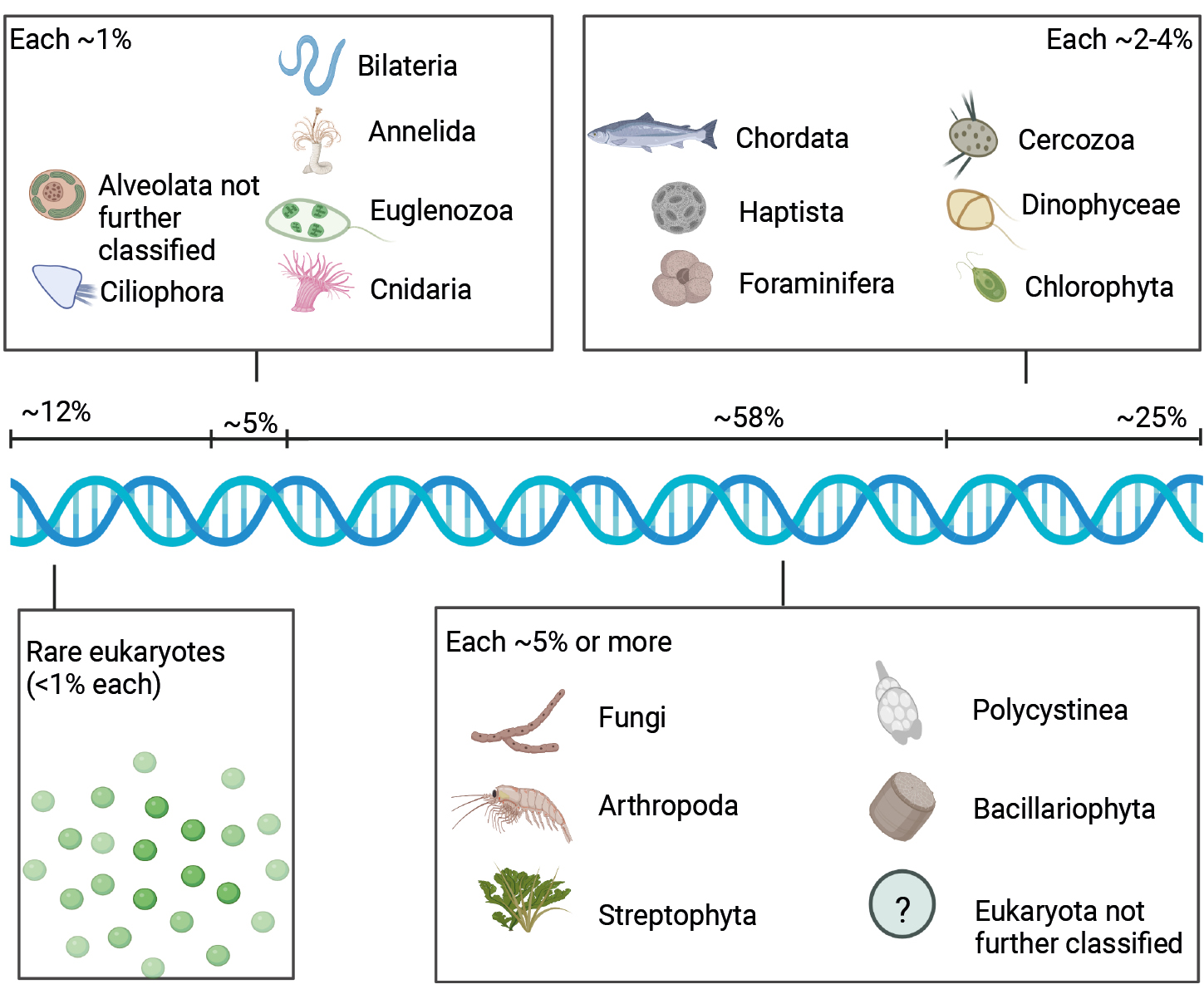 |
|
Figure 2: Overview and proportions of eukaryote groups that can be detected using sedaDNA in the Antarctic region. Approximate proportions (percentage of eukaryote groups out of total eukaryotes) are based on Armbrecht et al. (2022). Figure created with BioRender.com (note that icon selection depended on availability in BioRender and may not necessarily depict Antarctic species). |
Despite significant progress in sedaDNA research during recent years, the discipline is still in its infancy, with some baseline research questions needing to be addressed. For example, preservation biases are important to consider when interpreting sedaDNA data, yet little is known about such biases. It has been shown that sedaDNA degradation correlates with organic matter degradation (Armbrecht et al. 2022), but how well the DNA of certain species is preserved compared to that of others, and how far DNA can be transported with deep ocean currents, is currently unknown but would dramatically improve the accuracy of sedaDNA-derived ecosystem reconstructions.
sedaDNA is only preserved in trace amounts in the deep seafloor, and this scarcity makes it difficult to investigate rare species, which might sometimes be the most suitable indicators for specific environmental conditions. To overcome the hurdles of rare sequence detection in marine sedaDNA samples, high sequencing depths (acquiring many millions of reads) per sample is recommended and is becoming more affordable with the availability of today's next generation sequencing platforms. RNA-based hybridization capture techniques that enrich specific (e.g. rare) target sequences (Horn 2012) might further allow for more detailed investigations into higher-trophic-level organisms such as fish.
In summary, recent improvements in sedaDNA acquisition and analysis techniques in combination with sediment samples from locations characterized by ideal sedaDNA preservation conditions, such as those in polar ecosystems, make the application of this new proxy particularly promising for Antarctic paleo research, and open new doors to food-web-wide reconstructions over hundreds of thousands of years in this vulnerable, remote region. The depth and detail of the picture that sedaDNA can give us of past marine life is only just beginning to be explored.
affiliation
Institute for Marine and Antarctic Studies (IMAS), University of Tasmania, Hobart, Australia
contact
Linda Armbrecht: linda.armbrecht utas.edu.au
utas.edu.au
references
Armbrecht L et al. (2019) Earth-Sci Rev 196: 102887
Armbrecht L et al. (2022) Nat Commun 13: 5787
Barnes DKA et al. (2006) Glob Ecol Biogeogr 15: 121-142
Bensi M et al. (2022) Earth Syst Sci Data 14: 65-78
Capo E, Monchamp ME et al. (2022) Environ Microbiol 24: 2201–2209
De Schepper S et al. (2019) ISME J 13: 2566-2577
Flores H et al. (2012) Mar Ecol Prog Ser 458: 1-19
Horn S (2012) In: Shapiro B, Hofreiter M (Eds) Ancient DNA. Springer, 177-188
Karentz D (1989) Antarct J US 24: 175-176
Meredith MP et al. (2008) J Clim 21: 3327-3343
Pawłowska J et al. (2020) Sci Rep 10: 15102
Pierella Karlusich JJ et al. (2022) Mol Ecol Res doi: 10.1111/1755-0998.13592
Sylvan JB et al. (2021) Technical Note 4. International Ocean Discovery Program, 16 pp
Tada R et al. (2015) In: Tada et al. (Eds) Proc IODP 346.Integrated Ocean Drilling Program, 1-61
Weber ME et al. (2021) Proc IODP 382. International Ocean Discovery Program), 309 pp
Willerslev E, Cooper A (2005) Proc Royal Soc B 272: 3-16
Darrell Kaufman1, J. Hunter2 and N. McKay1
PAGES Data Stewardship project creates a one-stop-shop for PAGES 2k Network data products, while LiPDverse complements with additional analysis-ready datasets.
Data compilations generated by PAGES working groups are used in major science-synthesis products that address high-level global-change research topics. These data products are highly curated and extensively analyzed, with outcomes that are applied in a variety of contexts, including model–data comparisons. Such data compilations are valuable as snapshots of the data available at the time they were assembled. They typically include rich metadata for intelligent reuse and thereby can be merged with an ever-growing collection of paleodata. This pool of paleodata is valuable as it can be searched and analyzed with the intent of addressing new scientific research questions that go beyond an individual dataset. This complementary connection between individual data products and the collective aggregate of datasets is exemplified by the new PAGES 2k Network data portal, which gathers major data products from the PAGES 2k Network (pastglobalchanges.org/2k), and the LiPDverse, a data service for datasets built in the PaleoData (LiPD) framework (McKay and Emile-Geay 2016), which includes most PAGES 2k products (Fig. 1).
PAGES 2k data portal
The new PAGES 2k data portal (pastglobalchanges.org/science/wg/2k-network/database-map) describes each of the major data products and reconstructions that have been generated by the PAGES 2k Network over the past decade. Data products are organized according to their primary paleodata type and, where applicable, by regions. The portal summarizes the origin and purpose of each data product. It describes the data and metadata contents, and provides links for accessing the datasets and their corresponding publications. A mapping tool provides access to individual datasets within each product. This new platform advances PAGES' commitment to advancing FAIR data principles (PAGES Scientific Steering Committee 2018). It also provided an opportunity for its primary creator—PAGES data steward and early-career scientist, Jasmine Hunter (University of Wollongong, Australia)—to advance her coding and data management skills, while expanding her professional network globally.
LiPDverse
PAGES 2k data products are highly complementary with ongoing projects through LinkedEarth (linked.earth), including the LiPDverse (lipdverse.org). Many current and forthcoming PAGES 2k projects have curated their datasets in the metadata-rich and machine-readable LiPD framework. These products are available through the LiPDverse, a website where users can find, view, and download PAGES 2k and other paleodata compilations, or search for a subset of records within compilations. LiPDverse is an entry point to the LiPD "ecosystem" of analysis and visualization tools, including geoChronR, pyleoclim, and the forthcoming abrupt change toolkit in R (actR). Tools are available, and more are in development, for accessing LiPD-formatted data in R and python. These tools interact with datasets from both LiPDverse and from the Neotoma Paleoecology Database (neotomadb.org), with the goal of streamlining data discovery and analysis, and increasing reproducibility. A recent example based on West Africa paleoclimate records highlights how data from different sources can be assembled, analyzed, and visualized (McKay et al. 2022; earthcube2022.github.io/ec22_mckay_etal). Online tutorials are available to explain how LiPD tools can be applied to PAGES 2k data products, including Arctic2k (nickmckay.github.io/GeoChronR/articles/PCA.html) and Iso2k (nickmckay.github.io/GeoChronR/articles/tidyIso2k.html).
PAGES Data Stewardship Scholarship
The PAGES 2k Network was among the inaugural group of 11 Data Stewardship Scholarships awarded in 2021 (Kaufman 2022). The PAGES 2k data portal is an outcome of the project. PAGES Data Stewardship Scholarships recognize and reward PAGES working groups for their valued efforts to compile and curate data products for the long-term benefit of the global paleoscience community. Any member of a PAGES working group can apply for a Data Stewardship Scholarship; contact your working group leaders. For more information, see the PAGES website: pastglobalchanges.org/science/wg/data-stewardship-scholarship
affiliationS
1School of Earth and Sustainability, Northern Arizona University, Flagstaff, USA
2School of Earth, Atmosphere and Life Sciences, University of Wollongong, Australia
contact
Darrell Kaufman: Darrell.Kaufman nau.edu
nau.edu
references
Kaufman DS (2022) PAGES Mag 30: 62
McKay NP, Emile-Geay J (2016) Clim Past 12: 1093-1100
New scientific discoveries are usually achieved based on accumulated knowledge. We are "standing on the shoulders of giants", which is especially true when it comes to the utilization of vast knowledge held in public data repositories (Nieto-Lugilde et al. 2021). These open-access, often community-based data collections are critical to answer complex questions in any scientific domain. This is particularly important in the case of paleoscience, where continental-scale data collections allow us to study environmental changes in four dimensions. Comparing trends of change across several sites permits the separation of local site-specific changes from regional or continental patterns driven by climate and humans.
The European Pollen Database (EPD; europeanpollendatabase.net) has been one of the major public pollen data repositories for more than 30 years, adhering to the FAIR principles (Findability, Accessibility, Interoperability, and Reusability of digital assets) even before they were widely adopted (Wilkinson et al. 2016). The EPD serves as a tool to answer paleoecological (Giesecke et al. 2019), paleoclimate (Davis et al. 2003), and nature–human related research (Fyfe et al. 2015). The database is developed and curated by a volunteer group of data stewards led by Michelle Leydet. Currently, the EPD contains 2456 sites, including 5071 datasets integrating the Alpine Pollen and Archaeological Database (ALPADABA) (Fig 1). To provide timely data access and visualizations, the EDP community decided to join Neotoma (neotomadb.org) as a constituent database, thus contributing to Neotoma's development. Currently, all public data from the EPD are available via Neotoma.
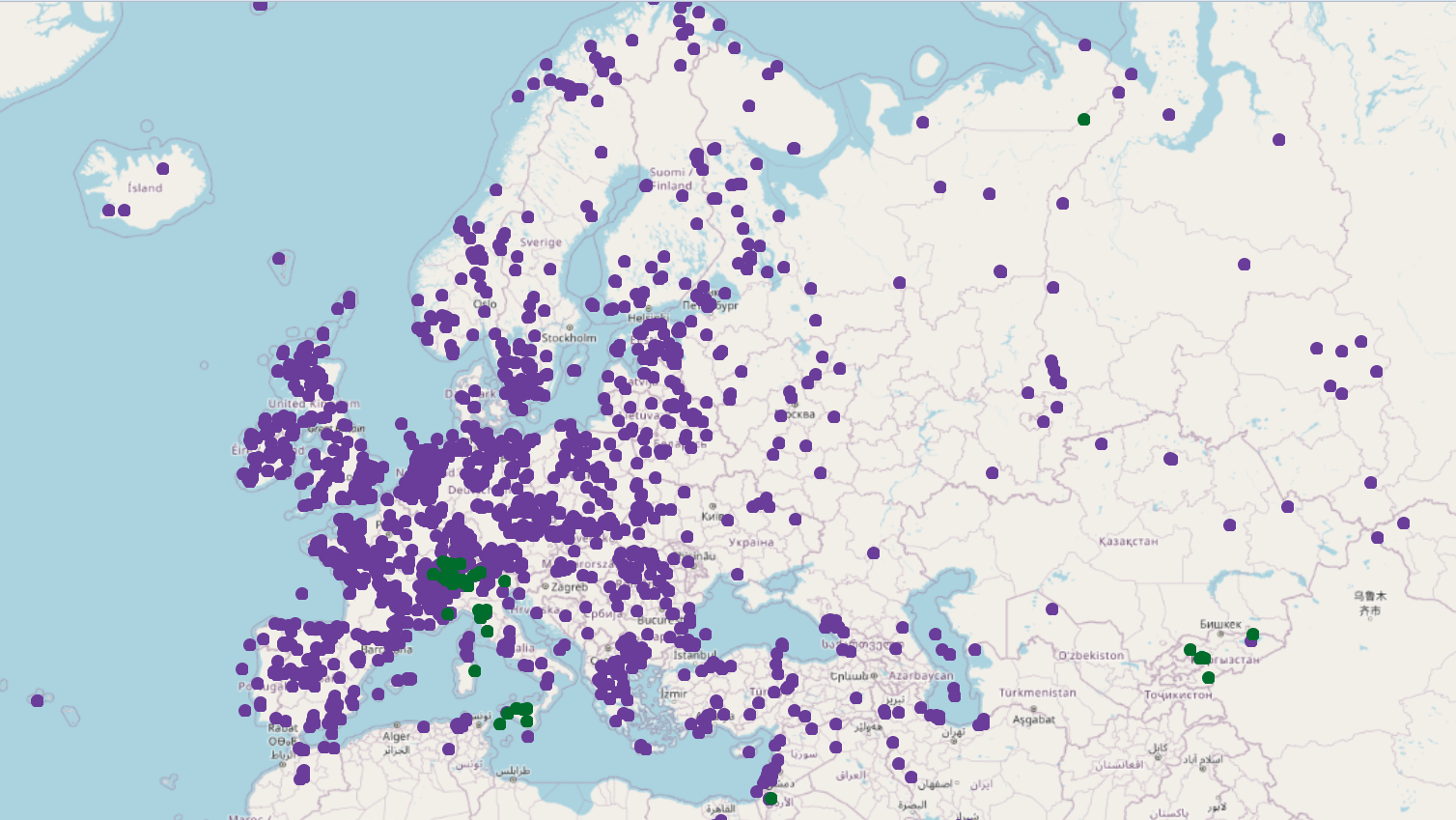 |
|
Figure 1: Current sites (2456) in the European Pollen Database (June 2022). Green dots belong to the ALPADABA database (56 sites). All sites have been successfully uploaded to Neotoma. Source: Neotoma explorer: apps.neotomadb.org/explorer |
While the number of datasets in the EPD increases steadily, there are regions for which published data are less available. The PAGES-supported in-person EPD Open Science Meeting (pastglobalchanges.org/calendar/128846; epdweblog.org/news-blog)gave another stimulus to scientists to submit their data to the EPD. The migration of the EPD to Neotoma opens new opportunities for storing other paleoecological proxy data, and for that reason the meeting aimed to attract other proxy communities to showcase Neotoma and start discussions. Therefore, topics of keynote talks were chosen to highlight some proxies that are well connected to pollen data: charcoal (E. Dietze), sedimentary ancient DNA (I. G. Alsos and U. Herzschuh), testae amoeba (K. Marcisz), biomarkers (C. De Jonge), vertebrate fauna (D. Schreve), and plant macroremains (L. Amon). T. Giesecke provided an introduction with insights on the history of pollen databases and the EPD, and J. Williams gave an overview of Neotoma. H. Seppä gave a talk on the application of the modern pollen dataset in climate reconstructions, and O. Mottl presented new tools and a workflow to analyze continental-scale pollen data held in Neotoma for specific research questions. The program was completed with two keynotes showcasing exciting local research programs, combining pollen data with information from archaeology (J. Kolář) and the use of herbaria collections to study recent continental-scale spread of neophytes (P. Mráz).
The EPD community sees the need to transfer the knowledge and skill required using the data in standard and sophisticated analyses in order to close the perceived gap between data producers and data users. To this end, attendees had the opportunity to participate in two training workshops out of seven different options: the use of non-pollen palynomorphs in multi-proxy studies (L. Shumilovskikh); how to produce quantitative land-cover reconstructions (M. Theuerkauf and V. Abraham); chronology building using classical and Bayesian statistics (P. Kuneš and G. Gil-Romera); the use of the Neotoma R package (S. Dominguez); inferring fire properties from charcoal timeseries using R (W. Finsinger); pollen-based climate reconstructions in R (B. Davis); and using Tilia to create pollen diagrams and to upload data to Neotoma (M. Leydet, G. Gil-Romera, and I. De Wolf). Participants highlighted the importance of these educational efforts during the workshops, judging them to have a strong impact on their future research and scientific development. In addition, this was the first face-to-face meeting after the COVID-19 pandemic for many attendees, becoming one of the very few occasions that early-career researchers may have to establish stronger networks with their peers early in their careers.
The EPD 2022 meeting was a success in terms of participation (112 people) and inclusivity: more than half were female (70%), with a high proportion of female keynote speakers. There was an impressive representation of early-career researchers (72%) and geographical locations (23 countries).
affiliationS
1Department of Ecology, Philipps-Marburg University, Marburg, Germany
2Instituto Pirenaico de Ecología, Spanish Scientific Research Council (IPE-CSIC), Zaragoza, Spain
3Department of Physical Geography, Utrecht University, The Netherlands
4Department of Botany, Faculty of Science, Charles University, Prague, Czech Republic
contact
Graciela Gil-Romera: graciela.gil ipe.csic.es
ipe.csic.es
references
Davis BAS et al. (2003) Quat Sci Rev 22: 1701-1716
Fyfe RM et al. (2015) Glob Chang Biol 21: 1197-1212
Giesecke T et al. (2019) Nat Commun 10: 5422
Irene Cornacchia, C. Boschi, P. Braico, P. Cristofanelli, A. Iadanza, P. Montagna, E. Regattieri and T. Tesi
Pisa, Italy, 22-24 June 2022
Climate change and the global carbon cycle have been influencing each other for millions of years. Yet, understanding and predicting the interactions between Earth's climate and carbon dynamics is challenging due to poorly constrained feedbacks and processes. Today, anthropogenic carbon dioxide emissions into the atmosphere–ocean system are altering the climate at unprecedented rates, making the understanding of carbon and climate dynamics one of the most crucial challenges for our society. To face this fundamental challenge, a new interdisciplinary approach is needed to embrace different geological, biological, and anthropic components with the overarching goal to produce a novel, global scientific view of the Earth system across timescales.
With this goal in mind, the working groups "Paleoclimate Dynamics" and "Carbon Cycle" of the Italian National Research Council (CNR) organized an international workshop "Climate Change and Carbon Cycle: Global change from the deep past to the Anthropocene". Over 70 people (most of them early-career scientists) from 10 countries attended. The workshop consisted of three sessions: Processes, Impacts, and Frontiers. The first session aimed to provide a better understanding on how fast and slow feedbacks in the carbon cycle operate to modulate the evolution of climate and its sensitivity to forcing through time, exploring triggers and tipping points. In this framework, the keynote speaker Prof. Marie Edmonds (Department of Earth Sciences, University of Cambridge, UK) presented the slow geological processes, mostly related to volcanism, that have exerted first-order control on the atmosphere and oceans over geologic timescales.
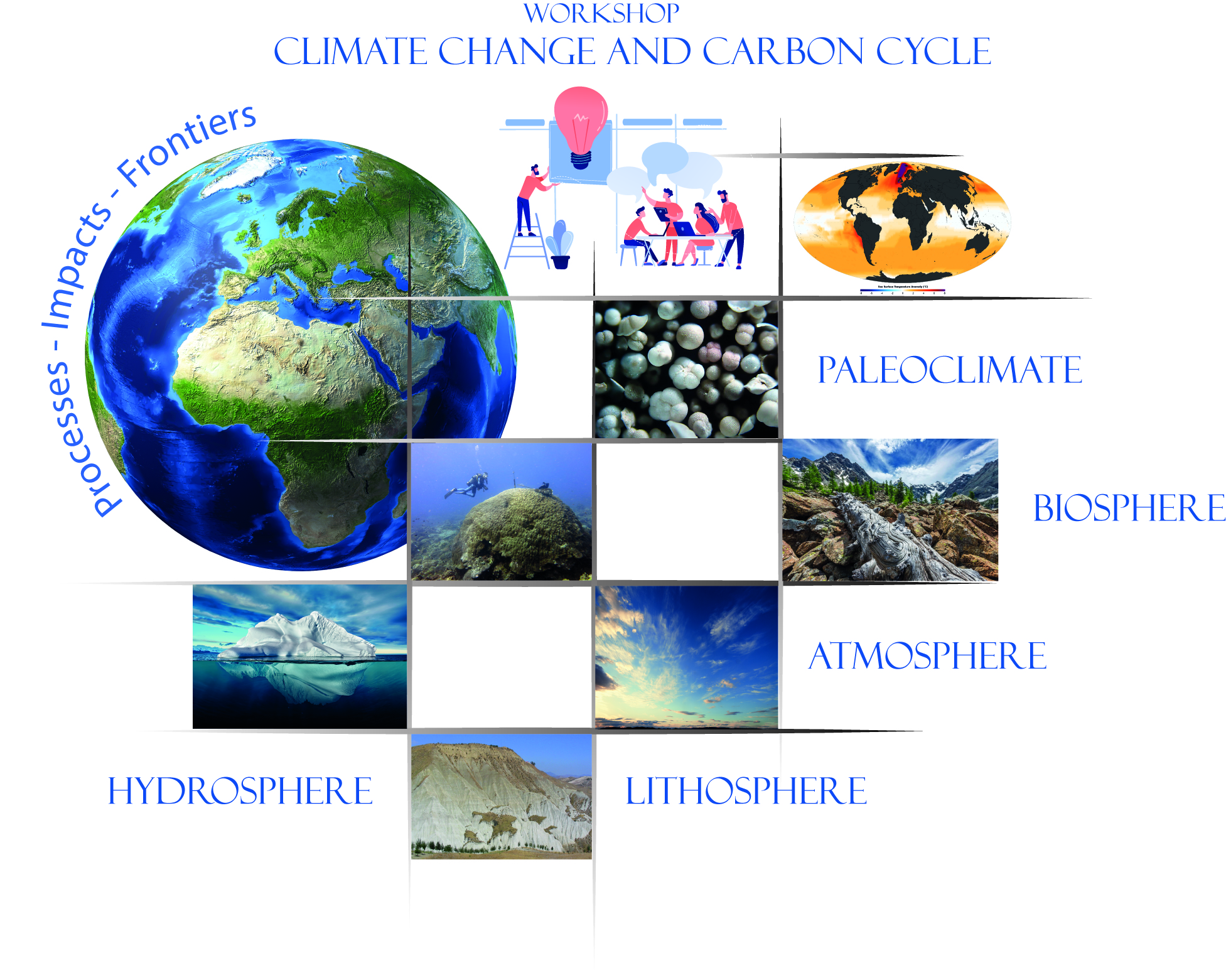 |
|
Figure 1: Sketch showing the different sources of information for studying the global carbon cycle and its relationship with climate across different timescales; keywords are also listed. |
The second session tackled the effects of climate changes and carbon-cycle perturbations on the different components of the Earth system over different time intervals, and with a multidisciplinary approach. In this session, the keynote speaker Dr. Richard Sanders (ICOS Ocean Thematic Centre, Norwegian Research Centre, Norway) discussed the consequences of the increasing CO2 concentration in the oceans, highlighting the importance of biogenic carbon, partly overlooked, when estimating the oceanic carbon budget and its rapid changes due to anthropogenic activities. Lastly, the third session focused on the analytical and conceptual boundaries in carbon-cycle–climate system research, to identify common/trans-scale knowledge gaps, and to stimulate discussion on how a combined effort is beneficial for both communities focusing on paleo and modern processes, to overcome current research limitations. The session was closed by keynote speaker Prof. Bärbel Hönisch (Department of Earth and Environmental Sciences, Columbia University, USA); her talk highlighted the importance of CO2 reconstructions over the past 60 million years to tackle the complex relations between this greenhouse gas and global temperature trends in the deep past.
During the workshop, participants traveled through space and time, from the Triassic–Jurassic mass extinction (~201 Myr BP) to the consequences of the 2020 lockdown on the riverine carbon cycle in Tuscan watersheds. Contributions covered research topics at different latitudes, from the Arctic to the Antarctic, and different climates, from the Alpine Critical Zone to the Mediterranean Sea, as well as urban environments. In addition, participants had the chance to visit five different laboratories with the goal of familiarizing themselves with new concepts and methodologies outside their scientific background. The research topics of these laboratories included forest modeling, IODP drilling initiatives, soil geochemistry, terrestrial ecosystem monitoring, marine carbon cycle, and carbonate rocks.
The overall inclusive approach of this workshop succeeded in gathering scientists working on topics of common interest despite the different research tools and timescales of interest. Collectively, the 2022 meeting in Pisa emphasized the need to forge a novel scientific community—multidisciplinary and transdisciplinary—well interconnected and open to new synergies among disciplines.
affiliation
Italian National Research Council (CNR), Rome, Italy
contact
Eleonora Regattieri: eleonora.regattieri igg.cnr.it
igg.cnr.it
Anne-Christine Da Silva1, N. Fagel1, D. Gutiérrez2, M. Yasuhara3 and M. Grégoire4
53rd International Colloquium on Ocean Dynamics & 3rd GO2NE Oxygen Conference, Liège, Belgium, 16-20 May 2022
This colloquium on ocean deoxygenation was organized by the IOC-UNESCO Global Ocean Oxygen Network (GO2NE) and was a contribution to the Global Ocean Oxygen Decade (GOOD) program of the UN Ocean Decade. The meeting involved 183 people onsite and 80 online participants.
During the colloquium, a session on "Ocean Deoxygenation - how the past can inform the future?" was convened by Moriaki Yasuhara, Dimitri Gutiérrez, Anne-Christine Da Silva, and Nathalie Fagel. The session started with Babette Hoogakker's keynote, which reviewed ongoing research on paleodeoxygenation, combining foraminifera geochemistry and climate model simulations, across key warm geological time intervals such as the Miocene and mid-Pliocene. In addition, the session involved 12 talks and 10 posters covering different approaches for reconstructing and interpreting past oxygenation conditions, their drivers, and their impacts on ocean life.
This approach was complemented by proxy development and calibration studies, as well as paleoclimate modeling of changes in ocean oxygenation. For example, past ocean anoxic events leading to mass extinctions that occurred during the Silurian and the late Devonian periods were studied in relation to their orbital forcing by Michiel Arts and co-authors (University of Liège, Belgium). Tim De Backer (University of Ghent, Belgium) then presented evidence of zooplankton malformations associated with increased levels of redox-sensitive metals at the onset of the Lau extinction event in the upper Silurian. Moriaki Yasuhara's talk (University of Hong Kong, Hong Kong) presented deoxygenation and warming impacts on shallow marine communities during the Paleocene–Eocene Thermal Maximum. He showed that habitat compression via oxygen minimum zone expansion occurred in this warmer-than-present condition. Rick Hennekam (NIOZ Institute, The Netherlands) revealed early warning signals of regime shifts associated with anoxic events (sapropels) in sediment records for the past 250 kyr in the Mediterranean Sea.
New insights for the use and interpretation of paleo-oxygenation proxies were presented, involving sedimentary redox-sensitive metals Uranium and Molybdenum by Mareike Paul (University of Helsinki, Finland) and Niels van Helmond (Utrecht University, The Netherlands), as well as trace metal enrichments (Mn/Ca) in the calcareous tests of foraminifera by Inda Brinkmann (University of Lund, Sweden). Notably, first results of tests of cold-water corals as recorders of intermediate water paleoredox state, through the evaluation of Cr and Cr isotope ratios, were discussed by Lelia Matos (CCMAR, Portugal).
Paleo reconstructions of changes in oxygen minimum zones (OMZs), and associated biogeochemical cycles, involving multiple proxies, were also presented. Catherine Davis (North Carolina State University, USA) used carbon and oxygen stable isotopes, trace metal concentrations, and morphological features of deep-dwelling planktic foraminifera to characterize the deglacial expansion of the Eastern Equatorial Pacific OMZ, and changes of mid-water oxygenation from the Last Glacial to the Holocene.
For reconstruction and understanding of coastal deoxygenation and eutrophication, Dimitri Gutiérrez (Insituto del Mar del Peru, Peru) presented a multi-proxy study, including dinocysts, geochemical proxies, and benthic foraminifera, to track cultural eutrophication in an upwelling-shadow bay of the Peruvian coast. By using state-of-the-art techniques, Constance Choquel (University of Lund, Sweden) used morphological variations of benthic foraminifera to characterize changes of oxygenation in the Baltic Sea over the past 200 years. Johannes Pein (Helmholtz-Zentrum Hereon, Germany) discussed modeling results to analyze the interplay between stratification and sedimentation driving oxygen depletion in coastal environments, with promising implications for management.
Finally, a paleoclimate modeling study by Vyacheslav Khon (Heriot-Watt University, UK) showed exciting results related to the drivers of the deep-ocean deoxygenation in the Last Glacial Maximum, highlighting the impacts of the Pliocene Panama Seaway closure on ocean circulation, net primary production and ventilation that have ultimately contributed to the development of the Eastern Pacific OMZ. Taken together, these studies emphasize the importance of the paleo approach to better understand past, present, and future ecosystems, biodiversity, and climatic impacts on them.
affiliationS
1Department of Geology, University of Liège, Belgium
2Instituto del Mar del Peru, Lima, Peru
3University of Hong Kong, Hong Kong
4MAST-FOCUS research group, Department of Astrophysics, Geophysics and Oceanography, University of Liège, Belgium
contact
Anne-Christine Da Silva: ac.dasilva uliege.be
uliege.be
Karst environments host a rich array of geological archives that allow us to improve our understanding of climatic and environmental changes, as well as landscape and human evolution. Such archives are commonly found in caves where they are both well connected, but also well protected from the surface, with the importance of clastic and chemical sediments being discussed at symposia for over 60 years (Dell'Oca 1961). Since 1996 in Bergen, Norway (Lauritzen 1996), Climate Change: The Karst Record (KR) has been the premier conference for international scientists to present and discuss the latest in cave and karst-based paleoclimate and paleoenvironmental research. Due to the major advances and developments in speleothem science over the last few decades (Henderson 2006), the conference naturally began focussing on speleothem-based research. For the recent KR9 conference (pastglobalchanges.org/calendar/26918), which was held at the University of Innsbruck, Austria, and online, the conference widened its focus. In addition to being a showcase for the latest speleothem research, the meeting also welcomed contributions from those working in the quickly developing (but disappearing) field of cave ice (Fig. 1), as well as the more traditional field of clastic sediments and speleogenetics.
Over three days, 183 delegates (including 34 online) from 30 countries presented 169 oral and poster presentations. PAGES provided funding for 15 delegates, including 11 early-career scientists and five researchers from developing countries. Climate variability on orbital, millennial, decadal, and seasonal timescales was a strong focus of the conference and included keynotes that examined opposite ends of the timescale spectrum. Heather Stoll (ETH Zürich, Switzerland) presented on North Atlantic meltwater pulses and temperature changes in the orbital session, whereas Ashish Sinha (California State University Dominguez Hills, USA) presented in the decadal session on the speleothem record of climate–society relationships in the Indian subcontinent. The integration of speleothem data in climate models and data–model comparisons was also discussed and explored further in a keynote by David McGee (MIT, USA), while Robyn Pickering's keynote on uranium–lead dating of speleothems from the Cradle of Humankind, South Africa, topped off the session on cave records of human history.
The majority of these presentations were focused on speleothem studies. Thus, an extensive review of cave monitoring, method and technical developments, and geochemical modeling and laboratory experiments, which aimed to improve understanding and analysis of the speleothem archive, were very welcome. A keynote by Hagit Affek (Hebrew University of Jerusalem, Israel) provided valuable insights into the continually developing speleothem 17Oexcess proxy. Beyond the speleothem topics, participants enjoyed presentations on the cave-ice archive, clastic sediments, and a diverse open session. Several presentations were also given online, including poster presentations, and, on the whole, the hybrid format generally worked as well as could be expected. Dakalo Maphanda (University of Witwatersrand, South Africa), Charlotte Honiat (University of Innsbruck, Austria), Melina Wertnik (ETH Zürich, Switzerland), and Marit Holten Løland (University of Bergen, Norway) all received outstanding student presentation awards.
Beyond the main plenary, participants had the possibility to participate in workshops where they developed knowledge and skills in using the Speleothem Isotopes Synthesis and AnaLysis (SISAL; pastglobalchanges.org/sisal) database, speleothem petrography and microstratigraphy, age modeling, and radiocarbon as both a geochronological tool and environmental tracer. Field trips were offered to Spannagel Cave (Spötl et al. 2002), the Hintertux glacier cave, and Eisriesenwelt, the largest ice cave in the world (Fig. 1).
As five years had passed since the last Karst Record meeting in Texas, USA, KR9 provided a much-needed and welcome opportunity for this small but rapidly developing community to meet and discuss developments in the field. In addition, a "mini summer school of speleothem science" took place for early-career researchers in the two days prior to KR9, providing valuable professional development opportunities. Free childcare was offered during the main conference, and KR9 was classified as a Green Event by the local authorities.
The competition to host KR10 was a close one! We look forward to KR10 in South Africa in 2025.
Acknowledgements
We would like to thank PAGES, the International Association of Sedimentology, the University of Innsbruck Rectorate and Faculty of Geo- & Atmospheric Sciences, the Innsbruck Tourism Board, Thermo Scientific, and Messer for their financial support.
affiliation
Institute of Geology, University of Innsbruck, Austria
contact
Gina E. Moseley: gina.moseley uibk.ac.at
uibk.ac.at
references
Dell'Oca S (1961) Riempimenti naturali di grotte. Rassegna Speleologica Italiana, 277 pp
Yuval Burstyn1,2, J. Bühler3,4, N. Kaushal5, K. Rehfeld4, K. Braun6, F. Lechleitner7 and Y. Goldsmith1
5th SISAL workshop, Jerusalem, Israel, and online, 28 February – 3 March 2022
Accurate model projections of future regional hydroclimate require validation against paleoclimate records. Speleothems, with their strong age control and multiple proxies, are a promising archive for this purpose (Bühler et al. 2021). During Phase 1 of the Speleothem Isotope Synthesis and Analysis working group (SISAL; pastglobalchanges.org/sisal), members of the group published a database containing nearly 700 speleothem isotope records, 500 of which have standardized age models (Comas-Bru et al. 2019). Data–model comparisons utilizing the database have yielded promising results, while stressing that more information from cave monitoring and additional proxies are needed to constrain the interpretation of isotope records, and to provide independent paleoenvironmental information. To address these gaps, the working group aims to expand the database with trace elements and monitoring records during Phase 2 (2020–2023).
This first workshop of Phase 2 was designed to:
- assess the spatial and temporal distribution of trace element data;
- formulate targeted research questions;
- discuss best practices for measurements, data standardization, reduction, and uncertainty estimates; and
- design the first steps for plans to augment the SISAL Phase 2 database with process-based modeling of the climate–karst–cave system.
The Jerusalem workshop was fully hybrid, with "handshake" sessions organized to connect working groups from the Asian, Australian, and American time zones with the Eastern Mediterranean and European time zones. Fourteen participants, including two senior researchers, and 12 early-career researchers (ECRs, including Master students, PhDs and postdocs) from 10 countries attended the workshop in person. About 10 additional participants joined online.
 |
|
Figure 1: Sites with monitoring data (SISALv2 and cavemonitoringgroup.wordpress.com) and entities from the SISALv2 database with trace element data superimposed in all SISALv2 entities (blue). The map is modified from The World Karst Aquifer Map (Goldscheider et al. 2020). |
On day 1 of the workshop, SISAL members joined the hosting researchers from the Institute of Earth Sciences at the Hebrew University of Jerusalem for a departmental symposium. The symposium hosted 21 speakers (eight talks and 13 short "elevator pitches"). Six senior scientists in the field of karst and climate research presented their research alongside 14 ECRs. In-person audience attendance averaged around 40, and over 60 participants joined online throughout the day.
On day 2, Dr. Nikita Kaushal presented an update of the SISAL Phase 2 work to date on monitoring, trace elements, and long-term data stewardship. This included the datasets identified by the regional coordinators (Fig. 1), database structure, data and metadata fields, quality control, and proposed timelines. Dr. István Hatvani presented the new graphical user interface (GUI) to increase accessibility to the existing SISAL database. The group then brainstormed potential research questions and assigned teams to explore each question. The emerging main research questions included potential proxy system models to bridge the gap between rainwater and speleothem isotopes, and how to find robust regional hydroclimate proxy mechanisms targeting the divalent trace element replacing calcium in speleothem carbonate. Given the time-intensive nature of input to the monitoring database, it was decided that the data input would be targeted and project-specific.
On day 3, the group put most effort into data input and quality control, creating a wish list for metadata, and listing potential datasets for upload. Finally, on day 4, the last work day, the participants were introduced to the karst hydrology model designed by Kübra Özdemir Çalli and Prof. Andreas Hartmann. For the remainder of the workshop, participants circulated between breakout sessions focused on the main research questions from day 2.
On the last day, participants enjoyed a geological field trip to the Soreq Cave, led by Drs. Miryam Bar-Matthews and Avner Ayalon from the Geological Survey of Israel. Later, Prof. Mordechai Stein guided the group to the Dead Sea rift, valley, and lake.
With the workshop concluded, the SISAL working group now has focused research questions that will guide the data collection. Research group leaders were assigned, and a timeline for achieving the goals of the working group was established. SISAL Phase 2 coordinators welcome new volunteers to help in data curation and join the different projects planned for the upcoming months; if interested, please contact SISAL at sisal.sc2 gmail.com.
gmail.com.
Acknowledgements
SISAL wishes to thank the hosts at the Earth Science Institute at the Hebrew University and the administrative staff for their patience as we rushed preparations for this first event in two years. The organizers thank Dr. Miryam Bar-Matthews, Dr. Avner Ayalon, and Prof. Mordechai Stein for their help, as well as PAGES, the Minerva Stiftung (grant 3063000253), and the Institute of Earth Sciences at the Hebrew University for their financial and logistical support.
affiliationS
1Institute of Earth Sciences, the Hebrew University of Jerusalem, Israel
2Institute of the Environment, University of California, Davis, CA, USA
3Institute of Environmental Physics, Ruprecht-Karls-Universität Heidelberg, Germany
4Department of Geoscience and Department of Physics, Geo- and Environmental Research Center, University of Tübingen, Germany
5Climate Geology Group, Department of Earth Sciences, ETH Zürich, Switzerland
6Institute of Human Origins, School of Human Evolution and Social Change, Arizona State University, Tempe, USA
7Department of Chemistry, Biochemistry and Pharmaceutical Sciences and Oeschger Centre for Climate Change Research, University of Bern, Switzerland
contact
Yuval Burstyn: Yuval.Burstyn mail.huji.ac.il
mail.huji.ac.il
references
Bühler JC et al. (2021) Clim Past 17: 985-1004
